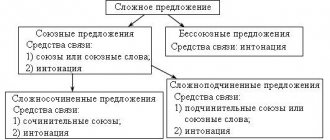What is syntax?
Language is the main means of communication between people. Language is closely related to human thinking and consciousness. We put our thoughts, and then our speech, into words and sentences. The knowledge about the world around us that people acquire in the process of work and research activities is enshrined in language - in words and phrases that form a sentence. The section of linguistics called “syntax” deals with the study of phrases and sentences which our speech is built.
Syntax is a branch of the science of language that studies phrases and sentences.
Syntax studies subordinating connections in a phrase, free and non-free phrases, a sentence from the point of view of its composition and structure. Syntax also controls the members of a sentence, the grammatical basis of a sentence, the types of simple and complex sentences.
By studying the syntax of the Russian language, we will learn to distinguish between complex, complex and non-union sentences, and use them in written and oral speech.
Syntax. Punctuation
Today we will answer such questions.
· Why do we need syntax?
· Why do we need punctuation?
· And how does syntax differ from punctuation?
We know that all sections of the language are related to each other
.
For example, phonetics studies letters and syllables. And graphics studies the letters that represent sounds. Vocabulary studies words, which, of course, consist of sounds. And they are written in letters. Morphemics studies the parts of a word - after all, you need to look at what words are made of!
Word formation explores how different parts of a word can be used to form new words. Word formation is related to morphology, because it studies the parts of speech, and you need to understand how they are formed.
But what is morphology related to? Really with nothing?
Of course not. Morphology is closely related to syntax
.
But what does syntax study? What is it for?
Syntax is very important and absolutely necessary.
After all, morphology really loves words and their forms. But with her they are always in complete disorder: scattered, not connected... Look, each form of the word seems to be separate. In all these forms it is difficult to guess the meaning. But it’s the syntax that should bring order.
In syntax, words are related to each other
. Let us connect by meaning the forms of the words that we see.
beautiful flowers
growing in a flowerbed
We've got the phrases!
Sentences are built from words and phrases in syntax
.
What sentences can we build? Beautiful flowers grow in a flower bed
.
How would we communicate if there were no syntax? Well, for example, at school a teacher would have to talk to students using separate words: who, go, answer, board.
The students' answers would sound no less strange: I, want, tell, phonetics.
And no one would understand each other.
So , syntax is a branch of the science of language in which phrases, sentences and text are studied. And also the rules for their construction.
By the way, the word syntax is ancient Greek. It means “arrangement, order, construction.”
Here you go. Now we know that syntax studies phrases, sentences, text... But isn't syntax connected with any section other than morphology? No, he has a constant, very persistent companion - Punctuation
.
Let's find out what she's studying.
Punctuation does follow Syntax all the time. As soon as the syntax decides: I’ll make a sentence! – like punctuation is already right there. “Put the punctuation, put the punctuation!”
“She’s really annoying,” thinks Syntax. “We should probably compose a text!” And Punctuation is not far behind: “Don’t forget the punctuation marks, don’t forget the punctuation marks...”
And everywhere you look - Punctuation: punctuation marks, punctuation marks... The syntax is already tired, it doesn’t know: how to escape from it?
No way. After all, you probably already guessed it.
Punctuation is a branch of the science of language that studies punctuation marks and the rules for their placement.
The word is Latin. And it comes from the word “punctum” - period.
And therefore syntax and punctuation are inseparable. After all, if we don’t put punctuation marks in sentences, we sometimes may not understand what we’re talking about.
Here, for example, are two phrases.
The difference between them is just the placement of one comma. But the meanings of these phrases are completely opposite. And if this comma were not there, how would we understand what it is about?
And vice versa, if we don’t know the syntax, we won’t be able to punctuate
.
Consider the sentence: The flowers in the flowerbed are red, blue, yellow
.
Why are punctuation marks needed here? Are they necessary? If we know the syntax, we can immediately answer: commas are placed between homogeneous members of a sentence.
Do not confuse syntax and punctuation errors!
Vasya touched the birch trunk.
The sentence is incorrectly constructed. That is, the wrong form of the word was chosen: you need to say “touched the birch trunk.” So it's a question of syntax. This is a syntax error.
But if we write: Vasya, I touched the birch trunk
... There are two extra commas in this sentence. After all, we have absolutely no need to separate the predicate with commas. If the error is related to punctuation marks, then it is a matter of punctuation. This is a punctuation error.
What do we need to remember?
Syntax and punctuation are branches of the science of language.
Syntax studies phrases, sentences and text. And also the rules for their construction.
Punctuation studies punctuation marks and the rules for their placement. The two branches of the science of language are closely related.
Educational material
- What is a phrase
- Subordinating connection in phrases and sentences
- Dependent word in a phrase
- Types of phrases: agreement, control, adjacency
- Types of phrases: verb, noun, adverb
- What combinations of words are not phrases
- What is a simple sentence
- The grammatical basis of a sentence
- Types of sentences by intonation and purpose of utterance
- Declarative sentences
- Interrogative sentences
- Incentive offers
- Non-exclamatory sentences
- Common and non-common offer
- Types of predicates
- Simple verb predicate
- Compound verb predicate
- Compound nominal predicate
- Adjective as a predicate
- Secondary members of the sentence
- Definition, addition, circumstance
- Agreed and non-agreed definitions
- Application in Russian
- Addition in Russian
- Direct and indirect object
- What is a circumstance
- Types of circumstances
- circumstance of time
- Circumstance of place
- Circumstance of the reason
- Circumstance of the goal
- Circumstance of condition
- Circumstance of the course of action
- What part of a sentence can an infinitive be?
- Homogeneous members of the sentence
- How to distinguish homogeneous and heterogeneous definitions
- Generalizing words for homogeneous sentence members
- Two-part and one-part sentences
- Definitely personal proposals
- Vaguely personal proposals
- Impersonal offers
- Name sentences
- Coordinating communication and coordinating conjunctions
- Compound Sentences
- Compound sentences with the conjunction “and”
- Compound sentences with the conjunction “or”
- Complex sentences
- Subordinating connection in a complex sentence
- Subordinating conjunctions and allied words in NGN
- What is a conjunction word
- Complex sentences with subordinate clauses
- Complex sentences with attributive clauses
- Complex sentences with adverbial clauses
- Complex sentences with subordinate tenses
- Complex sentences with comparative clauses
- Complex sentences with an action clause
- Complex sentences with several subordinate clauses
- Complex sentences with sequential subordination
- Complex sentences with homogeneous subordination
- Complex sentences with heterogeneous subordination
- What is a participle phrase
- What is a qualifying word
- What is a defined word
- Sentences with a participial phrase after the word being defined
- What is an adverbial phrase
- What is comparative turnover
Syntax as a branch of the science of language
The section of linguistics, which is called “syntax,” is based on the study of phrases and sentences both in the Russian language and in the field of literature.
This is interesting: tautology is what it is, examples.
Syntax studies the syntactic structure of delivered speech and language , i.e. sentences, phrases, their construction, ways of including phrases in a sentence, consolidating constructions in the text, as well as combining and forming words in complex sentences, etc. About the fact that studies syntax and its definition is more accurately described in Wikipedia.
Syntax. Wikipedia. Definition
Syntax (translated from ancient Greek “σύν-ταξις” - “composition”) is a branch of linguistics that studies the construction and functional interaction of different parts of speech in text sentences, short phrases and other units of linguistic speech . In grammar it is considered an integral part. The various questions of a syntactic nature being studied affect the field of study of such a science as morphology.
Syntax is a branch of the science of language that studies sentences and phrases, the main subsections of which are the syntax of sentences and phrases.
A phrase is a unit of syntax that is a combination of two or more independent words that are related to each other grammatically and in meaning. A phrase consists of a main word and dependent words.
This is interesting: how are uppercase and lowercase letters written?
The sentence is the basic unit of syntax and language; one or more words containing a question, message or motivation (advice, request, order) ; characterized by semantic completeness (i.e., it represents a statement) and intonation; includes a grammatical basis, which includes the main members, namely the subject and the predicate, or one of them.
Syntax Sections
- phrase syntax;
- simple sentence syntax;
- complex sentence syntax;
- text syntax.
There is a difference between a sentence and a phrase that needs to be determined and not to mix these units into one whole, since they are of different levels, despite the fact that the need to study them in one linguistic discipline reunites them.
This is necessary to create various syntactic constructions (i.e., words are initially combined into phrases, and then sentences are made from phrases). The sentence in this case acts as a stronger and improved syntactic construction. It is organized differently: unlike a phrase, it contains a grammatical basis. Simple sentences consist of one grammatical stem, while more complex ones consist of several.
Distinctive examples:
- “lie on the stove” (phrase);
- “Emelya slept on the stove” (simple with one grammatical basis: “Emelya” (subject) “slept” (predicate));
- “While Emelya was sleeping on the stove, buckets went for water” (complex with two grammatical stems: 1) “Emelya was sleeping”; 2) “the buckets were gone”).
Good to know: Parcellation according to the rules of the Russian language







